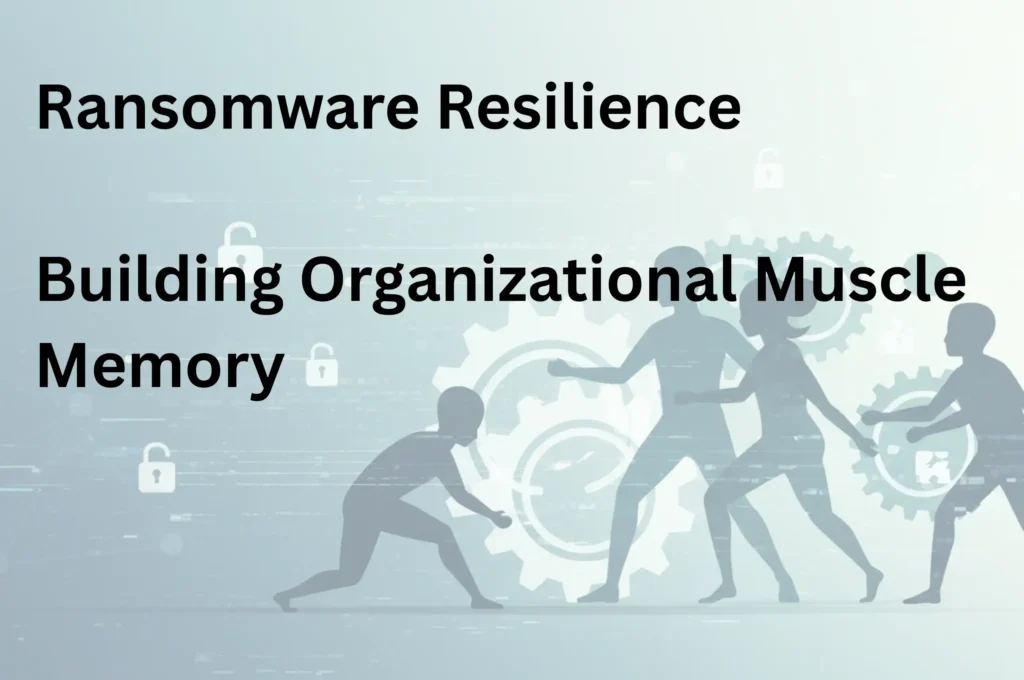Ransomware Resilience. Ransomware is no longer just a nuisance; it’s a rapidly evolving and major threat to businesses across every sector. With attacks increasing significantly, as evidenced by reports showing nearly half of all data breaches involving ransomware, the traditional defenses of technology and basic training, while crucial, can no longer guarantee absolute protection. The stark reality is that survival in today’s threat landscape hinges on one critical factor: your organization’s inherent ability to respond with speed, precision, and unwavering resolve, ultimately recovering stronger than before. This guide focuses on building robust ransomware defense.
Think of it like an elite athlete preparing for a high-stakes competition. Success isn’t merely about having the best equipment or knowing the rules; it’s about honed agility, quick, decisive thinking under pressure, and a deep-seated “muscle memory” built through rigorous, consistent training and practice. This isn’t just about being faster than the “tiger” (the attacker); it’s about achieving peak organizational athleticism.
This comprehensive guide will walk you through building that essential organizational muscle memory, transforming your incident response (IR) plan from a static, dusty document into a living, breathing, and highly effective capability.
Also Read: Sending Emails vis SMTP Relay

Ransomware Resilience: Building Organizational Muscle Memory
Plan Your Workout: Laying the Foundation for Cybersecurity Preparedness
Just like a world-class athlete customizes their fitness regimen to fit their unique body, strengths, and weaknesses, your organization needs a deeply personalized approach to cybersecurity preparedness. The first, and most critical, step is to truly understand your organizational “body” – what makes it resilient, and what could potentially break it under attack.
Assume Breach: Physical Vulnerability Assessment
The foundational principle here is to assume breach. Instead of asking if an attack will happen, you must operate under the assumption that it will. This mindset shift is transformative. It compels you to proactively identify and understand your externally facing potential points of compromise. Where are your digital doors and windows? What are the common entry vectors? This isn’t just about listing known vulnerabilities; it’s about understanding how an initial foothold can provide an attacker with the ability to discern your entire environment, map your critical assets, and strategically move within your systems to inflict the highest amount of pain and disruption.
This deep dive involves:
- External Attack Surface Mapping: Identifying all internet-facing assets, including forgotten or shadow IT.
- Vulnerability Scanning & Penetration Testing: Actively testing your defenses from an attacker’s perspective.
- Cloud Configuration Audits: Ensuring cloud environments are securely configured and not exposing sensitive data.
- Supply Chain Risk Assessment: Understanding the vulnerabilities introduced by third-party vendors and partners.
Scope Your Mental Vulnerability: Cultivating an Organizational Mindset
Beyond the technical “physical” aspects, you need to strengthen the organizational “mind” and sharpen collective perception. This means fostering a culture of hyper-awareness that extends from every employee to the highest-level executives. Complacency or a lack of focus among your staff is akin to blood in the water for an attacker, making your organization susceptible to social engineering, phishing, and other deceptive tactics.
To cultivate this robust mental fortitude:
- Regular Security Awareness Training: Move beyond annual checkboxes. Implement engaging, frequent training that addresses current threats and real-world scenarios.
- Phishing Simulations: Regularly test your employees’ vigilance with realistic phishing attempts and provide immediate, constructive feedback.
- Role-Based Training: Tailor training to specific roles, highlighting the unique threats and responsibilities relevant to their daily tasks.
- Leadership Buy-in: Ensure executives not only understand but actively champion cybersecurity as a core business imperative, setting the tone for the entire organization.
- Foster a Culture of Skepticism: Encourage employees to question suspicious emails, links, and requests, no matter how legitimate they appear.
Warm Up: Essential Cybersecurity Training and Preparation
You’ve designed your personalized workout plan and cultivated a resilient mindset. Now, it’s time to get limber and prepare your organization for the real workout. This stage focuses on training the cognitive capabilities of your organization, ensuring everyone understands the operational landscape and can anticipate potential threats before they escalate.
- Document Environmental Ebbs and Flows: This involves deeply understanding the normal course of business operations. What are your peak hours? What systems are most active? What are the typical data flows? Identify your most important assets and how they are touched in your daily operations. Knowing your “normal” is crucial for detecting “abnormal.”
- Identify Dangerous Scenarios (“Put Yourself Out of Business”): This is a critical exercise in proactive threat modeling. Gather key stakeholders and brainstorm the most dangerous scenarios that could impact business continuity and critical assets. Don’t shy away from worst-case scenarios. What if your primary data center is hit? What if your entire payment system is encrypted? This helps prioritize risks and identify gaps in your current defenses and response plans.
- Know Your Limits: It’s not enough to simply have an incident response plan; you need to recognize the subtle business and operational anomalies that indicate something is wrong and when swift investigative action is needed. This goes beyond automated “anomaly detection” in technology. Your team should know your business well enough, and have communication strong enough, to sense when something is “off” – a sudden drop in transaction volume, an unusual login time, an unexpected email from a vendor. These human insights are invaluable early warning signs.
- Attack Your Weaknesses: Once you’ve stretched your muscles by envisioning threats and understanding your baseline, it’s time to push yourself. Know your strengths, but more importantly, honestly acknowledge, thoroughly document, and proactively attack all your weaknesses to take them off the table. This means not just identifying vulnerabilities but creating concrete action plans to mitigate or eliminate them.
Train, Recover, and Repeat: Mastering Your Incident Response Plan
Now it’s time to sweat… metaphorically. This is where the organizational muscle memory is truly built through consistent, repetitive, and challenging practice. This section explores different training techniques to hone your organization’s response capabilities, ensuring they become second nature.
Hone Motor Skills: Breach Dry Runs
The first part of the workout is to hone your organization’s “motor skills” for incident response. This means performing regular breach “dry runs” – simulated attacks that test your systems and, more importantly, your people. The organization needs to establish and run through clear, actionable processes for activation, escalation, and response. This is a top-to-bottom exercise that needs to become second nature, ensuring everyone knows their role and responsibilities without hesitation. These aren’t just technical drills; they include communication flows, decision-making processes, and external stakeholder engagement.
Increase Reps: Communication Cadence
The efficacy of so many incident response processes lives or dies in communication. You need to increase your “reps” in communication practice. Engage and maintain a regular cadence of communication practice between key stakeholders, both internal (IT, legal, PR, executives) and external (law enforcement, customers, regulators). Play out critical potential scenarios until the organization speaks with one fluid, confident voice. This ensures that during a real crisis, information flows seamlessly, decisions are made swiftly, and external messaging is consistent and accurate.
Adjust Difficulty: Advance Your Training
As your organization becomes more comfortable with, and stronger in, these exercises, it’s time to change it up and adjust the difficulty. You might say the first step is to “spot yourself.” This means stepping back from the established processes and making an honest assessment of shortcomings. Completion of a drill isn’t success; true success lies in continuous improvement. Every process and playbook can be better. Identify and fill in gaps, introduce unexpected twists, or simulate more sophisticated attack vectors to push your team’s boundaries.
Cross Training: Keep Perspective Sharp
Repetition is great for building muscle memory, but it can also breed complacency. Here’s where “cross-training” becomes invaluable to keep your organizational mind and perspective sharp. Many successful organizations find it useful to break up and vary response element practices for shorter, more focused sessions. This might involve:
- Mini-drills: Focusing on a single aspect, like data exfiltration or system isolation.
- Scenario variations: Running the same attack vector but with different initial indicators or compromised systems.
- Role-swapping: Having team members practice roles outside their primary function. This approach allows revisiting and rethinking how to get better from multiple perspectives and at different points in the process, preventing stagnation and fostering adaptability.
Measure Your Gains: Assess Organizational Fitness
They say “measure twice, cut once.” However, in the realm of cybersecurity, once you’ve gotten yourself “cut” (experienced an incident or a drill), you need to be always measuring to ensure you maintain and improve that organizational fitness. In assessing that fitness, as stated previously, simply completing a drill does not quantify success. You need to check performance, not just compliance boxes.
After any and all Tabletop exercises, breach simulations, or even real incidents, you should be asking:
- Did you resolve the incident effectively and efficiently? Beyond just stopping the attack, how quickly was it contained, eradicated, and recovered from?
- Can you identify and close the gaps for continuous improvement? What went wrong? What could have been better? Document lessons learned meticulously.
- Is your collaboration strong with internal and external stakeholders? Were communication lines clear? Did all parties understand their roles?
- Is everyone on the same page regarding roles, responsibilities, and protocols? Are there any lingering confusions or misunderstandings?
- Are we getting better? Track key metrics over time to demonstrate improvement in response times, containment, and recovery.
Finally, as with any workout regimen, reinforcement and detachment are also great tools. So, find a workout buddy. Third-party Offensive Security firms or specialized incident response consultancies don’t need to rip down and rebuild your organizational understanding from scratch. Once you’ve discovered your process and defined your metrics, these Offensive Security partners can provide invaluable outside validation and honest, unbiased assessment. They can offer fresh perspectives on your blind spots and provide expert blueprints for further improvement, ensuring your organizational muscle memory is truly robust and ready for any challenge.
This post discusses on topics: ransomware recovery, enterprise cybersecurity, cyber attack response, security awareness training, phishing simulations, vulnerability assessment, threat modeling, incident response best practices, cybersecurity strategy, organizational agility in security, ransomware resilience, incident response plan, cybersecurity preparedness, cybersecurity training, ransomware defense.

YouTube Hindi Channel Link:

YouTube English Channel Link:

YouTube Channel Link:

YouTube Channel Link